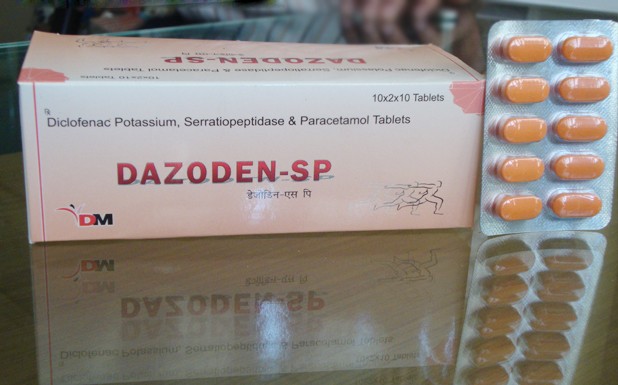Paracetamol, also known as Acetaminophen, is commonly used for its analgesic and antipyretic effects. Serratiopeptidase is a proteolytic enzyme (protease) produced by Enterobacterium Serratia sp. E-15 used in the prevention of pain and swelling.
Indications and Usage:
Diclofenac Potassium:
● For treatment of primary dysmenorrhea.
● For relief of mild to moderate pain.
● For relief of the signs and symptoms of osteoarthritis.
● For relief of the signs and symptoms of rheumatoid arthritis.
Paracetamol:
● For mild to moderate pain (from headaches, menstrual periods, toothaches, backaches, osteoarthritis, or cold/flu aches and pains).
● To reduce fever.
Serratiopeptidase:
● Anti-inflammatory properties.
● Post-traumatic swelling.
● Fibrocystic breast disease.
● Bronchitis.
Rationale of Combination:
Product Description:
Diclofenac potassium is used as an anti-inflammatory agent to pacify mild to moderate pain and inflammation. Common conditions associated with pain and inflammation includes arthritis, trauma, surgery and fibermyalgia whereas paracetamol is used for temporary relief of fever, minor aches, and pains. Additionally, serratiopeptidase helps to reduce fluid retention in affected areas, which contributes to proper drainage and a quicker recovery.
Pharmacology:
Diclofenac Potassium:
Diclofenac is an acetic acid non-steroidal anti-inflammatory drug (NSAID) with analgesic and antipyretic properties. Diclofenac inhibits the production of prostaglandins by inhibiting COX-1 and COX-2 pathways thereby exhibiting anti- inflammatory effects.
Absorption: Well absorbed following oral administration.
Distribution: widely distributed in animals. Plasma protein binding exhibited is >99%.
Elimination: Hepatic metabolism leads to elimination through urine.
Serratiopeptidase:
Serratiopeptidase is an enzyme isolated from a non-pathogenic bacteria called Enterobacteria Serratia E15. Serratiopeptidase has powerful anti-inflammatory properties and is particularly useful for post-traumatic swelling, fibrocystic breast disease and bronchitis. It is able to digest dead tissue, blood clots, cysts, and arterial plaques.
Absorption: On oral administration, serratiopeptidase is absorbed in GI tract.
Distribution: Distributed throughout the body tissues, unchanged via systemic circulation. It reaches in higher concentration in inflamed tissues. Serratiopeptidase levels in inflammatory exudates rises gradually with decline in blood levels indicating that serratiopeptidase is quite rapidly transferred to the site of inflammation.
Paracetamol:
Paracetamol is a widely used analgesic and antipyretic agent.
Absorption: Paracetamol is well absorbed in gastro intestinal tract. Oral bioavailability is dose dependant since the half life of Paracetamol is 1-3hrs. Distribution:Paracetamol is distributed throughout the body fluids in a homogeneous way. Paracetamol given at therapeutic doses binds to plasma proteins at less than 20%.
Elimination: Metabolites are excreted through the kidneys in the urine.
Adverse Effects:
● Skin rash
● Diarrhea
● Gastrointestinal disturbance/Abdominal pain (or stomach pain)/Heartburn or
● Nose bleed
● Nausea
● Allergic reactions
● Dizziness
Contraindications:
Contraindicated in patients with severe ulcer gastrointestinal bleeding, and hypersensitivity. Diclofenac sodium and Serratiopeptidase is contraindicated in patients with asthma, renal or hepatic disorders, hypertension, porphyria, peri- operative pain in CABG surgery patients and bleeding disorders.
Drug Interactions:
Diclofenac potassium, Serratiopeptidase should not be taken concomitantly with other NSAIDs, anticoagulants including low-dose/LMW heparin, sucralfate, triamterene, cyclosporine, cholestyramine, colestipol, digoxin, aspirin, methotrexate and lithium whereas Paracetamol reduces the absorption of cholestyramine within 1 hour of administration whereas it accelerates the absorption with metoclopramide.
Precautions:
Paracetamol causes increased risk of liver damage in chronic alcoholics along with an increased risk of toxicity with high doses or long term administration of barbiturates, carbamazepine, hydantoins, isoniazid, rifampin and sulfinpyrazone. Diclofenac potassium , should be taken with food. Take the drug immediately after meals to avoid GI disturbances.
